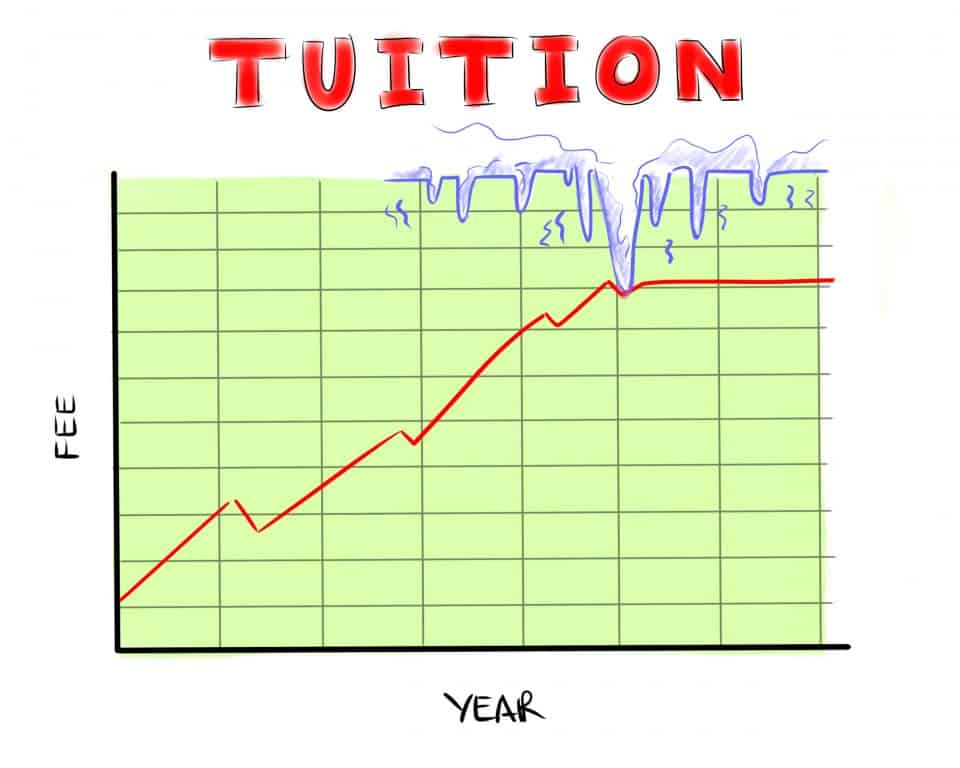[dropcap]Earlier[/dropcap] this month, the newly elected Alberta NDP government instituted a two-year tuition fee freeze for post-secondary institutions in the province. Initially the policy comes across as sensible and well intended, yet like many government policies that seem seductive on the surface it is not as golden as the wheat fields for which the province is renowned.
Currently, median tuition fees in Alberta are approximately $5,700. However, there’s no doubt that the cost of attending a university or college in this country has skyrocketed over the last couple of decades. That said, a tuition freeze is the wrong way to solve the problem.
The first thing to consider is the economic effect of such a policy. As enrolment in post-secondary education increases, and government support stagnates, tuition fees are naturally going to have to rise in order for institutions to meet rising demand. Frozen tuition fees create a system where there are more applicants and fewer available places. As a result, institutions have to be more selective in the students they accept. Naturally, they will select the best applicants.
The results of this should be fairly obvious — if an institution is compelled to reject applicants, it is going to reject the lower-performing tier of students. It is likely that there is a correlation between those students who perform poorly and those students who come from households from lower tax brackets. As a result, those likely to be rejected are likely to be from lower-income families. Consequently, what is intended as a measure to help those who cannot afford the cost of a degree actually ends up hurting them.
Until 1998, this was a chronic problem in the United Kingdom. As baby boomers came of age in the mid-60s, institutions faced a surge in enrolment demand. However, post-secondary institutions, dependant on government funding, were forced to limit enrolment and accept only the smartest applicants — in essence, exercising the opposite intention of the policy. It wasn’t until 1998 when the UK instituted a nominal tuition fee of £1,000 that this problem was alleviated. Although the case in Alberta is not as extreme as that in the UK, it is important to reflect on the calamitous effects of government manipulation.
In an effort to address any funding concerns, the Alberta government has increased the budget of its Ministry of Advanced Education. Yet as the opportunity cost of attending a post-secondary institution declines for many Albertans, the government of Alberta should focus on providing student loans and grants, and not stifling institutions’ access to revenue.
Matthew Pick, an Albertan studying at U of T, echoes a similar sentiment: ““I fear that the policy will take focus away from other elements of affordability of higher education, such as the costs borne by rural students — who, on average are less affluent than their urban counterparts — to move to cities to pursue higher education.”
The Alberta government’s policy does set a precedent as students, universities, and the provincial government grapple with the highest tuition fees in the country. As fiscal austerity becomes a de facto policy of Western economics and more and more young people enrol in post-secondary education, higher tuition fees are inevitable. Furthermore, higher education is still, and will remain, a massively beneficial investment. Although we hear about students ‘drowning in debt’ after graduation, over one third of students absolve their debt within three years.
Provinces will inevitably have to come up with solutions to ensure that those who cannot afford post-secondary education have access to it. Shifting the onus onto institutions, however, is not the way to go about it.
Jonathan Wilkinson is a fourth-year student at University College studying international relations.


